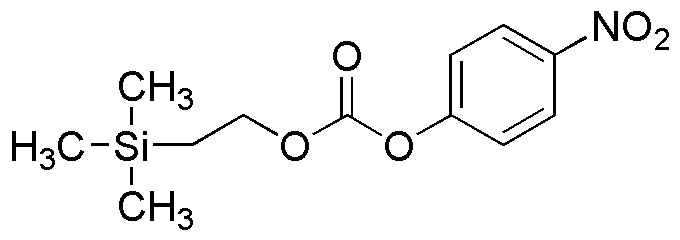4-Nitrophenyl 2-(trimethylsilyl)ethyl carbonate is widely utilized in research focused on:
- Organic Synthesis: This compound serves as a versatile reagent in organic chemistry, facilitating the synthesis of various complex molecules due to its ability to participate in nucleophilic substitution reactions.
- Pharmaceutical Development: It plays a crucial role in the development of pharmaceutical intermediates, aiding in the creation of drug compounds with enhanced bioactivity and stability.
- Analytical Chemistry: Used as a derivatizing agent in chromatography, it helps improve the detection and quantification of target analytes, making it valuable in quality control laboratories.
- Material Science: This chemical is employed in the formulation of advanced materials, contributing to the development of coatings and polymers with improved properties, such as increased durability and resistance to environmental factors.
- Bioconjugation: It is utilized in bioconjugation techniques, allowing researchers to attach biomolecules to surfaces or other molecules, which is essential in the fields of diagnostics and therapeutic development.
General Information
Properties
Safety and Regulations
Applications
4-Nitrophenyl 2-(trimethylsilyl)ethyl carbonate is widely utilized in research focused on:
- Organic Synthesis: This compound serves as a versatile reagent in organic chemistry, facilitating the synthesis of various complex molecules due to its ability to participate in nucleophilic substitution reactions.
- Pharmaceutical Development: It plays a crucial role in the development of pharmaceutical intermediates, aiding in the creation of drug compounds with enhanced bioactivity and stability.
- Analytical Chemistry: Used as a derivatizing agent in chromatography, it helps improve the detection and quantification of target analytes, making it valuable in quality control laboratories.
- Material Science: This chemical is employed in the formulation of advanced materials, contributing to the development of coatings and polymers with improved properties, such as increased durability and resistance to environmental factors.
- Bioconjugation: It is utilized in bioconjugation techniques, allowing researchers to attach biomolecules to surfaces or other molecules, which is essential in the fields of diagnostics and therapeutic development.
Documents
Safety Data Sheets (SDS)
The SDS provides comprehensive safety information on handling, storage, and disposal of the product.
Product Specification (PS)
The PS provides a comprehensive breakdown of the product’s properties, including chemical composition, physical state, purity, and storage requirements. It also details acceptable quality ranges and the product's intended applications.
Certificates of Analysis (COA)
Search for Certificates of Analysis (COA) by entering the products Lot Number. Lot and Batch Numbers can be found on a product’s label following the words ‘Lot’ or ‘Batch’.
*Catalog Number
*Lot Number
Certificates Of Origin (COO)
This COO confirms the country where the product was manufactured, and also details the materials and components used in it and whether it is derived from natural, synthetic, or other specific sources. This certificate may be required for customs, trade, and regulatory compliance.
*Catalog Number
*Lot Number
Safety Data Sheets (SDS)
The SDS provides comprehensive safety information on handling, storage, and disposal of the product.
DownloadProduct Specification (PS)
The PS provides a comprehensive breakdown of the product’s properties, including chemical composition, physical state, purity, and storage requirements. It also details acceptable quality ranges and the product's intended applications.
DownloadCertificates of Analysis (COA)
Search for Certificates of Analysis (COA) by entering the products Lot Number. Lot and Batch Numbers can be found on a product’s label following the words ‘Lot’ or ‘Batch’.
*Catalog Number
*Lot Number
Certificates Of Origin (COO)
This COO confirms the country where the product was manufactured, and also details the materials and components used in it and whether it is derived from natural, synthetic, or other specific sources. This certificate may be required for customs, trade, and regulatory compliance.

